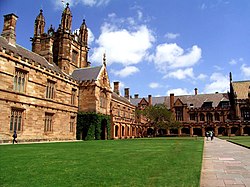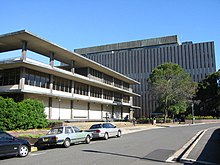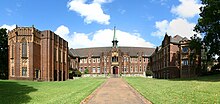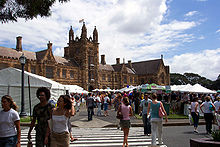| The University of Sydney | |
|---|---|
 | |
| Latin: Universitas Sidneiensis | |
| Motto | Sidere mens eadem mutato (Latin) |
| Motto in English | Literal: "Though the constellations change, the mind is universal" [1] Meaning: The traditions of the older universities of the Northern Hemisphere are continued here in the Southern |
| Established | 1850 |
| Type | Public |
| Endowment | AU$829m (31 December 2008)[2] |
| Chancellor | Her Excellency Professor Marie Bashir AC, CVO[3] |
| Vice-Chancellor | The Reverend Dr Michael Spence |
| Staff | 3,081 (FTE academic, 2008) |
| Students | 47,775 (2009) |
| Undergraduates | 31,634 (2009) |
| Postgraduates | 16,141 (2009) |
| Location | Sydney, NSW, Australia 33°53′16″S 151°11′14″E / 33.88778°S 151.18722°E |
| Campus | Urban, Parks |
| Colours | Blue, Gold & Red |
| Affiliations | Group of Eight, APRU, ASAIHL, WUN |
| Website | Sydney.edu.au |
 | |
The University of Sydney (informally Sydney University or simply Sydney) is the oldest university in Australia. It was established in Sydney in 1850. In 2009, the university had 47,775 students making it the second largest (behind Monash University) in Australia.[4]
The University’s reputation has been built on the breadth of disciplines that it offers to students, and the quality and impact of its research. It is renowned for the activity of its student life (Germaine Greer and Clive James cut their teeth at Sydney, as did the Chaser team) and is consistently ranked by the National Union of Students as offering the best student experience in Australia. Increasingly it has been working to broaden both its student intake, through scholarships and programs like the Compass Project, and its commitment to environmental sustainability, through its Institute for Sustainable Solutions.
The University has a number of small special-purpose satellite campuses obtained from other organisations over the past 20 years, however the main campus is centred on the large Oxbridge-inspired grounds [5] which spread across the suburbs of Camperdown and Darlington on the south-western outskirts of the Sydney CBD.
The University of Sydney is a member of Australia's Group of Eight, Academic Consortium 21, the Association of Pacific Rim Universities (APRU) and the Worldwide Universities Network.
History
During 1848, in the New South Wales Legislative Council, William Wentworth proposed a plan to expand the existing Sydney College into a larger university. Wentworth argued that a state university was imperative for the growth of a society aspiring towards self-government, and that it would provide the opportunity for 'the child of every class, to become great and useful in the destinies of his country'. It would take two attempts on Wentworth's behalf, however, before the plan was finally adopted.
The University was established via the passage of the University of Sydney Act,[6] which was signed on 1 October 1850. Two years later, the University was inaugurated on 11 October 1852 in the Big Schoolroom of what is now Sydney Grammar School. The first principal was John Woolley. On 27 February 1858 the university received its Royal Charter from Queen Victoria, giving degrees conferred by the university rank and recognition equal to those given by universities in the UK.[7] By 1859, the university had moved to its current site in the Sydney suburb of Camperdown.
In 1858, the passage of the Electoral Act provided for the University to become a constituency for the New South Wales Legislative Assembly as soon as there were 100 graduates with higher degrees. This seat in Parliament was first filled in 1876, but was abolished in 1880 one year after its second Member, Edmund Barton, was elected to the Legislative Assembly.
Most of the estate of John Henry Challis was bequeathed to the University, which received a sum of £200,000 in 1889. This was thanks in part due to William Montagu Manning (Chancellor 1878–1895) who argued against the claims by British Tax Commissioners. The following year seven professorships were created; anatomy, zoology, engineering, history, law, logic & mental philosophy, and modern literature.

1950-2000
The New England University College was founded as part of the University of Sydney in 1938, and separated to become the University of New England in 1954.

During the late 1960s, the University of Sydney was at the centre of rows to introduce courses on Marxism and feminism at the major Australian universities. At one stage, newspaper reporters descended on the university to cover brawls, demonstrations, secret memos and a walk-out by Professor David Armstrong, a respected philosopher who held the Challis Chair of Philosophy from 1959 to 1991, after students at one of his lectures openly demanded a course on feminism.[8] The philosophy department split over the issue to become the Traditional and Modern Philosophy Department, headed by Armstrong and following a more traditional approach to philosophy, and the General Philosophy Department, which follows the French continental approach.
Under the terms of the Higher Education (Amalgamation) Act 1989 (NSW)[9] the following bodies were incorporated into the university in 1990:
- the Sydney Branch of the Sydney Conservatorium of Music
- the Cumberland College of Health Sciences
- the Sydney College of the Arts of the Institute of the Arts
- the Sydney Institute of Education of the Sydney College of Advanced Education
- the Institute of Nursing Studies of the Sydney College of Advanced Education
- the Guild Centre of the Sydney College of Advanced Education.
Prior to 1981, the Sydney Institute of Education was the Sydney Teachers College.

The Orange Agricultural College (OAC) was originally transferred to the University of New England under the Act, but then transferred to the University of Sydney in 1994, as part of the reforms to the University of New England undertaken by the University of New England Act 1993[10] and the Southern Cross University Act 1993.[11] In January 2005, the University of Sydney transferred the OAC to Charles Sturt University.
2000-present
In 2001, University of Sydney Chancellor Dame Leonie Kramer was forced to resign by the university's governing body.[12] In 2003, Nick Greiner, a former premier of New South Wales, resigned from his position as chair of the university's Graduate School of Management because of academic protests against his simultaneous chairmanship of British American Tobacco (Australia). Subsequently, his wife, Kathryn Greiner, resigned in protest from the two positions she held at the university as chair of the Sydney Peace Foundation and a member of the executive council of the Research Institute for Asia and the Pacific.[13] In 2005, the Public Service Association of NSW and the Community and Public Sector Union were in dispute with the university over a proposal to privatise security at the main campus (and the Cumberland campus.)[14]
In February 2007, the university agreed to acquire a portion of the land granted to St John's College to develop the Sydney Institute of Health and Medical Research. As a Roman Catholic institution, in handing over the land St John's placed limitations on the type of medical research that could be conducted on the premises, seeking to preserve the essence of the College mission. This has caused concern among some groups, who argue that this could interfere with scientific medical research. However, this is rejected by the university administration because the building is not intended for this purpose and there are many other facilities in close proximity where such research can take place.
At the start of 2010, the University controversially adopted a new logo. It retains the same University Arms, however takes on a more modern look. There have been stylistic changes, the main one being the coat of arm's mantling, the shape of the escutcheon (shield), the removal of the motto scroll, and also others more subtle within the Arms itself such as the mane and fur of the lion, the number of lines in the open book, and the colouration.[15] The Coat of Arms continues to be used for more formal purposes, such as on testamurs.[citation needed]
 Stylised shield | Logo (includes shield) |  Coat of arms |
University rankings
In 2009, QS World University Rankings positioned in 2nd place both the University of Sydney and University of Melbourne in Australia. The University of Sydney as a whole was placed 36th overall in the world [16]. On the ARWU rankings, University of Sydney is placed within the top 10 in the Asia Pacific. According to Reuter's recent research publication, University of Sydney was the biggest non-government research institute in the Australia-New Zealand (Oceania) region. Apart from that, outside the Australian government's research arm, the university has consistently been the largest recipient of research grants in the country over the last 10 years, particularly in medicine.
Notable alumni
Throughout its history, University of Sydney alumni have made significant contributions to Australia and beyond. Australian leaders who have graduated from the university include two governors-general, five prime ministers, four chief justices of the High Court of Australia, and twenty other justices of the High Court, as well as the first president of the United Nations General Assembly and three Nobel laureates.
Individual alumni include:
- H. V. Evatt - Politician and jurist.
- John Howard - Politician and Prime Minister.
- Clive James - Entertainer.
- Germaine Greer - Writer & feminist.
- John Bell - Actor.
- Ian Biggs - Diplomat.
Organisation


The university comprises sixteen faculties:[17]
- Faculty of Agriculture, Food and Natural Resources
- Faculty of Architecture, Design and Planning
- Faculty of Arts
- Faculty of Dentistry
- Faculty of Economics and Business
- Faculty of Education and Social Work
- Faculty of Engineering and Information Technologies
- Faculty of Fine Arts
- Faculty of Health Sciences
- Sydney Law School
- Sydney Medical School
- Faculty of Music
- Faculty of Nursing and Midwifery
- Faculty of Pharmacy
- Faculty of Science
- Faculty of Veterinary Science
The four largest faculties by (2009) student enrolments are (in descending order): Arts; Economics and Business; Health Sciences; Science. In 2009, together they comprise 57% of the university's students. Each contains a student enrolment over 4,850, and they are indeed the only such faculties.[18] It is notable that the Faculty of Economics and Business, disproportionately to other faculties consists of about 49% international students, whilst the Sydney-university-wide average rate is about 22% (2008).
Endowments and research grants


The University of Sydney currently has financial endowments totaling $829 million. A drop due to recent downturn of the global economic situation. The university's turnover, in turn, was A$ 1.3 billion in 2008.
Latest figures show that the University of Sydney has received the highest amount of research grants, which may demonstrate its research competitiveness and the size of its students and staff body.[4] The University of Sydney also has the second largest (behind Monash University) body of students and researchers among Australian universities.
The University of Sydney secured more than $46 million in funding in the 2007 round of National Health and Medical Research Council (NHMRC) Project Grant, Capacity Building and Fellowship awards, the largest allocation to any university in the state. The James Jones foundation has announced the 2007 recipient of the bicentennial award in university research linked to applied agricultural economics. The award includes various grant and research opportunities that may be taken up by both staff members and senior students. Five of the university's affiliated medical research facilities secured $38 million in the Australian government's 2006 budget, part of $163 million made available for a variety of development and expansion projects.
Campus
Main campus
The main campus is spread across two inner-city suburbs of Sydney: Camperdown and Darlington.
Originally housed in what is now Sydney Grammar School, in 1855, the government granted the university land in Grose Farm, three kilometres from the city, which is now the main Camperdown campus. The architect Edmund Blacket designed the original Neogothic sandstone Quadrangle and Great Tower buildings, which were completed in 1862. The rapid expansion of the university in the mid-20th century resulted in the acquisition of land in Darlington across City Road. The Camperdown/Darlington campus houses the university's administrative headquarters, and the Faculties of Arts, Science, Education and Social Work, Pharmacy, Veterinary Science, Economics and Business, Architecture, and Engineering. It is also the home base of the large Faculty of Medicine, which has numerous affiliated teaching hospitals across the state.
The main campus is also the focus of the university's student life, with the student-run University of Sydney Union (known as 'the Union') in possession of three buildings - Wentworth, Manning and Holme Buildings. These buildings house a large proportion of the university's catering outlets, and provide space for recreational rooms, bars and function centres. One of the largest activities organised by the Union is the Orientation Week (or 'O-week'), centring on stalls set up by clubs and societies on the Front Lawns.
The university is currently undertaking a large capital works program with the aim of revitalising the campus and providing more office, teaching and student space.[19] The program will see the amalgamation of the smaller science and technical libraries into a larger library, and the construction of a central administration and student services building along City Road. A new building for the School of Information Technologies opened in late 2006, and has been located on a site adjacent to the Seymour Centre. The busy Eastern Avenue thoroughfare has been transformed into a pedestrian plaza, and a new footbridge has been built over City Road. The new home for the Sydney Law School, located alongside Fisher Library on the site of the old Edgeworth David and Stephen Roberts buildings, has been completed.

From 2007, the university will also use space in the former Eveleigh railway yards, just to the south of Darlington, for examination purposes.
The campus is well served by public transport, being a short walk from Redfern Railway Station and served by buses on the neighbouring Parramatta Road and City Road.[20]
Satellite campuses

- Mallett Street campus: The Mallett Street campus is home of the Faculty of Nursing. As of 2005, the Faculty no longer offers undergraduate Bachelor of Nursing programs. A new Master of Nursing program (M.N) has been introduced, with its first intake of students in 2006. Other hybrid programs such as the Bachelor of Arts/Master of Nursing, Bachelor of Science/Master of Nursing, Bachelor of Applied Science/Master of Nursing, Bachelor of Sports and Exercise Science/Master of Nursing have also been introduced.
- Cumberland campus: Formerly an independent institution (the Cumberland College of Health Sciences), the Cumberland campus in the Sydney suburb of Lidcombe was incorporated into the university as part of the higher education reforms of the late 1980s. It is home to the Faculty of Health Sciences, which covers various allied health disciplines, including physiotherapy, speech pathology, radiation therapy, occupational therapy, as well as exercise science and health information management.
- The Sydney Dental Hospital located in Surry Hills and the Westmead Centre for Oral Health which is attached to Westmead Hospital. See: Sydney Faculty of Dentistry.
- St James campus: This building in Phillip Street is near the Supreme Court and was the location of the Sydney Law School until 2009. The law school is now primarily located on the Camperdown campus in a purpose-built facility, with postgraduate programs still run from the St James campus.
- Rozelle Campus: The Sydney College of the Arts (SCA) is based in a former sanitorium in the Sydney suburb of Rozelle, overlooking Port Jackson. The college specialises in the fine (visual) arts.
- Sydney Conservatorium of Music: Formerly the NSW State Conservatorium of Music, the Sydney Conservatorium of Music (SCM) is located in the Sydney CBD on the edge of Sydney's Royal Botanic Gardens, a short distance from the Sydney Opera House. It became a faculty of the university in the 1990s and incorporates the main campus Department of Music, which was the subject of the documentary Facing the Music.
- Orange Agricultural College: Located at Orange in rural NSW, the Orange Agricultural College joined in 1994. Orange campus was principally the domain of the former Faculty of Rural Management; however other undergraduate courses from the Faculties of Arts, Science, Nursing and Pharmacy were also taught at Orange. The Orange Campus and the Faculty of Rural Management were transferred to Charles Sturt University in 2005.
- Camden campus: Located on Sydney's southwest rural fringe, the Camden campus houses research farms for agriculture and veterinary science.
- The Narrabri Plant Research Centre is located at Narrabri, near the Queensland border.
- Taylors College: Located at Waterloo, New South Wales, NSW, this college is operated by the university for its Foundation Program, catering to international students wishing to enter the university.
Facilities and services
University of Sydney Library

The University of Sydney Library consists of thirteen individual libraries located across the university's various campuses. According to the library's publications, it is the largest academic library in the southern hemisphere;[21] university statistics show that in 2007 the collection consisted of just under 5 million physical volumes and a further 300,000 e-books, for a total of approximately 5.3 million items.[22] The Rare Books Library possesses several extremely rare items, including one of the two extant copies of the Gospel of Barnabas and a first edition of Isaac Newton's Philosophiae Naturalis Principia Mathematica.
Museums and galleries
- Nicholson Museum of Antiquities contains the largest and most prestigious collection of antiquities in Australia. It is also the country's oldest university museum, and features ancient artefacts from Egypt, the Middle East, Greece, Rome, Cyprus and Mesopotamia, collected by the University over many years and added to by recent archaeological expeditions.
- The Macleay Museum is named after Alexander Macleay, whose collection of insects begun in the late eighteenth century was the basis upon which the museum was founded. It has developed into an extraordinary collection of natural history specimens, ethnographic artifacts, scientific instruments and historic photographs.
- The University Art Collection was founded in the 1860s and contains more than 2,500 pieces, constantly growing through donation, bequests, and acquisition. It is housed in several different places, including the Sir Hermann Black Gallery and the War Memorial Art Gallery.
- The Rare Books Library is a part of the Fisher Library and holds 185,000 books and manuscripts which are rare, valuable or fragile, including eighty medieval manuscripts, works by Galileo, Halley and Copernicus and an extensive collection of Australiana. The copy of the Gospel of Barnabas, and a first edition of Philosophiae Naturalis Principia Mathematica by Sir Isaac Newton are held here. Regular exhibitions of rare books are held in the exhibition room.
Residential colleges



The university has a number of residential college and halls of residence each with its own distinctive style and facilities. All offer tutorial support and a wide range of social and sporting activities in a supportive communal environment. Five colleges are affiliated with religious denominations and while this gives each of these colleges a special character, students of any denomination or religion are eligible for admission. Unlike some residential colleges in British or American universities, the colleges are not affiliated with any specific discipline of study. "Intercol" refers to the six colleges which exist on campus. They are modelled on the British system of colleges and competition for entry is high each year. The Colleges compete in the Rawson Cup (sport for men) the Rosebowl cup (sport for women) and the Palladian Cup (drama, debating and music for both men and women).
- St John's College
- St Andrew's College
- St Paul's College
- Sancta Sophia College
- Wesley College
- The Women's College
The Univerity also has three other residential systems, which are very different to the colleges, and are not part of the intercol system. For a variety of important reasons, the intercol network has chosen to have no affiliation with these "houses".
- Mandelbaum House
- International House, University of Sydney
- Sydney University Village [2]
There is also a university-affiliated housing cooperative, Stucco.
Student organisations


- Student Representatives: Politically and academically, undergraduate students are represented by the Students Representative Council (SRC) and postgraduate students by the Sydney University Postgraduate Representative Association (SUPRA).
- University of Sydney Union: The University of Sydney Union (USU) is the oldest and largest university union in Australia. USU provides a range of activities, programs, services and facilities geared at giving students the university experience. This involves delivering a huge Clubs and Societies program, a varied entertainment program, student opportunities, a range of catering and retail services plus buildings and recreational spaces for students, staff and visitors.
- Sydney Uni Sport and Fitness: Formerly known as the Sydney University Sports Union and Sydney University Women's Sports Association, Sydney University Sport is one of Australia's largest tertiary sporting bodies. It currently manages and administers 42 sport and recreation clubs, organises sporting and recreation events, and offers student and non-student members a comprehensive range of sporting facilities.
The SRC and Union are both governed by student representatives, who are elected by students each year. Elections for the USU Board of Directors occur in first semester; elections for the SRC President, and for members of the Students' Representative Council itself, occur in second semester, along with a separate election for the editorial board of the student newspaper Honi Soit, which is published by the SRC. The elections are usually closely contested, and result in much of the main campus being covered with chalk messages from the various candidates. However, some complaints have been made in the pages of Honi Soit and other publications about the organisations' claims to represent the student body, citing perennially low voter turnouts and the general apathy of much of the university population to student politics.
The future of these organisations was believed to be under a shadow with the passage of legislation implementing voluntary student unionism in late 2005. The legislation prohibited the compulsory collection of fees from students, which had been the customary means of funding student organisations, after the beginning of Semester 2 of 2006. Although the organisations continue to be concerned about their long-term financial viability, they have secured significant funding from the university to partially make up for lost revenue.
Miscellaneous
Statistics
 Sources of income for Sydney University, 1900-2003 |  Enrolments at the University of Sydney, 1880-2009 |  Proportion of enrolments by faculty, 1900-2005 |
Gallery
 The Darlington Centre |  The Anderson Stuart Building |  Eastern Avenue on main campus (prior to recent redevelopment) |  The new School of Information Technologies building |
 View of main quadrangle |  The liquid nitrogen tank outside the School of Chemistry |  Badham Library | |
 Graffiti Tunnel during campaigning period for 2009 student election |  Statue of Gilgamesh, main campus |


No comments:
Post a Comment